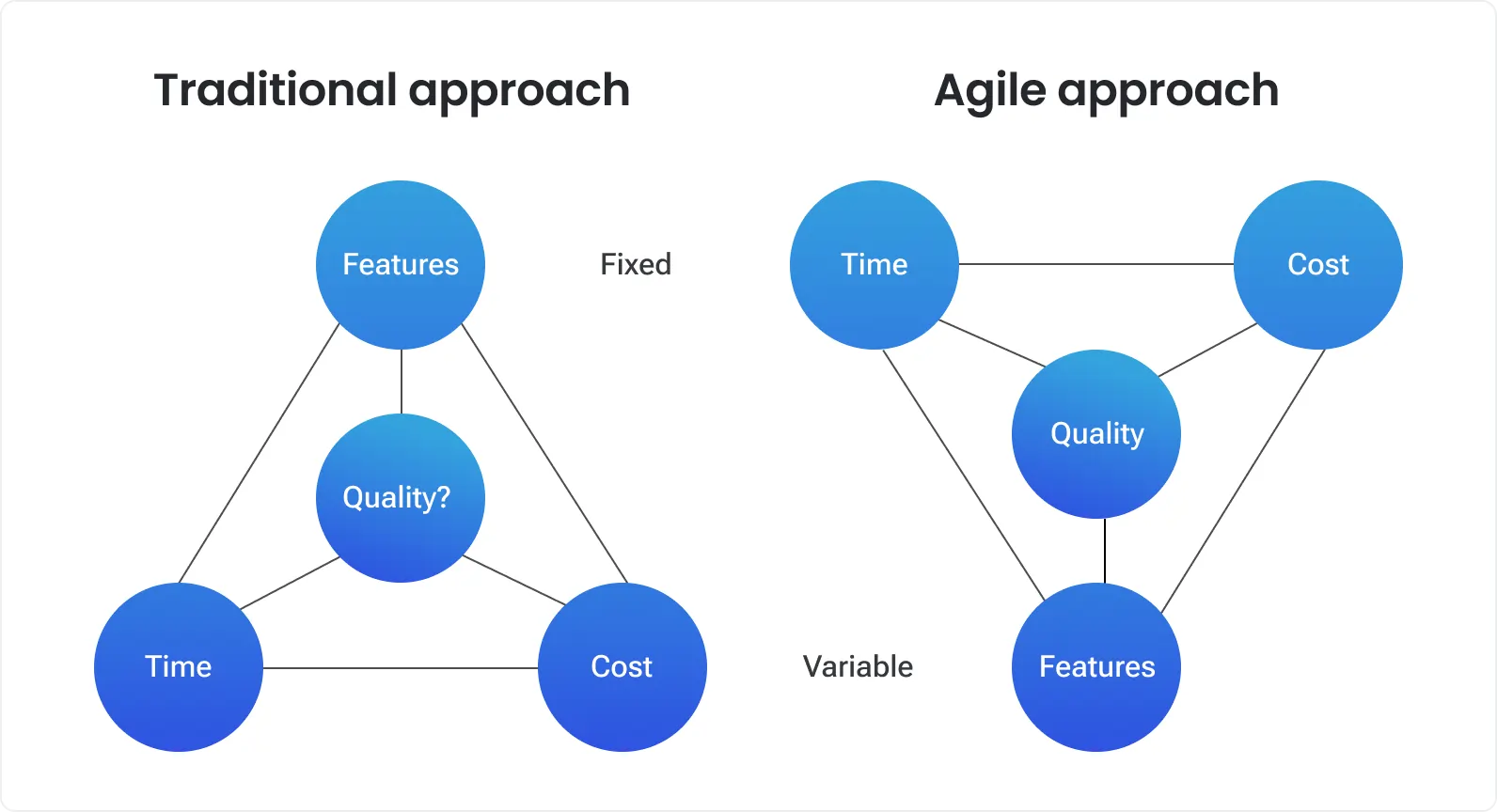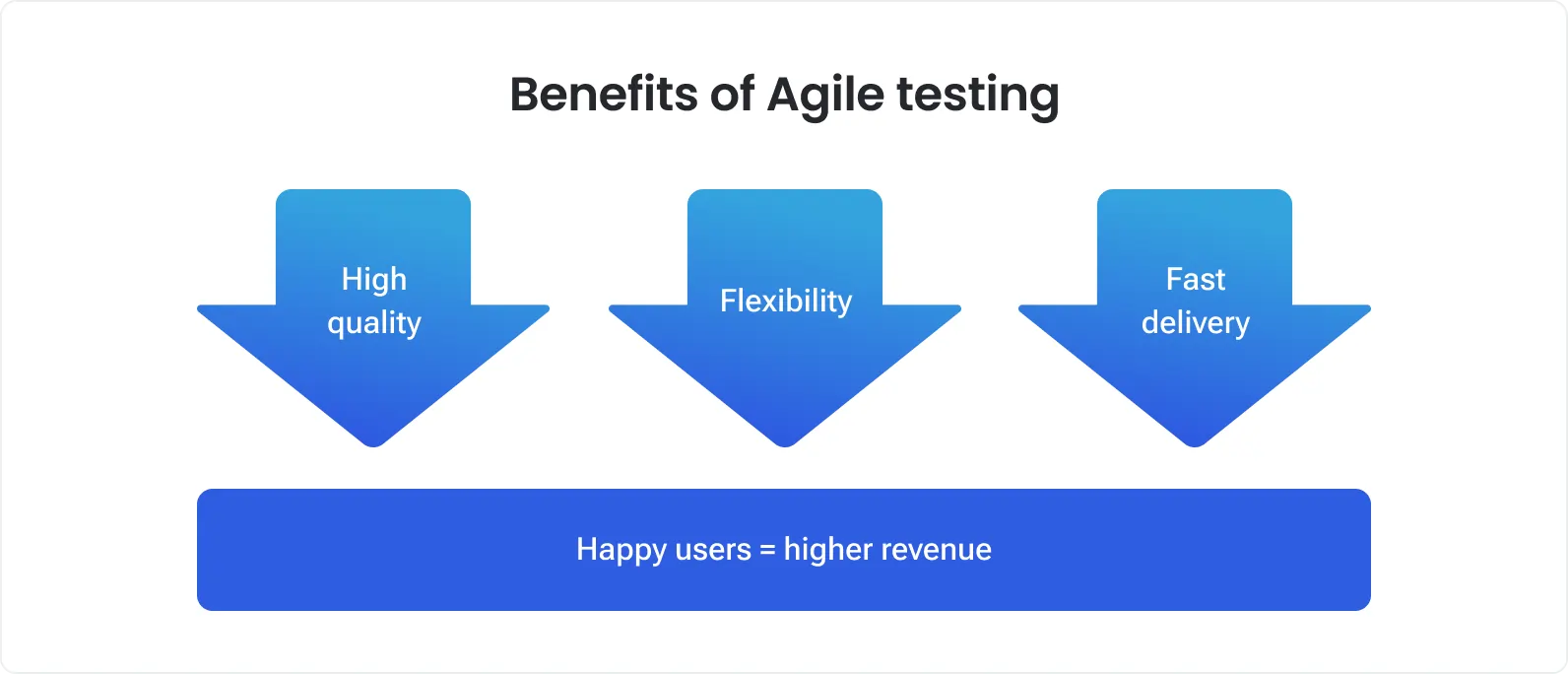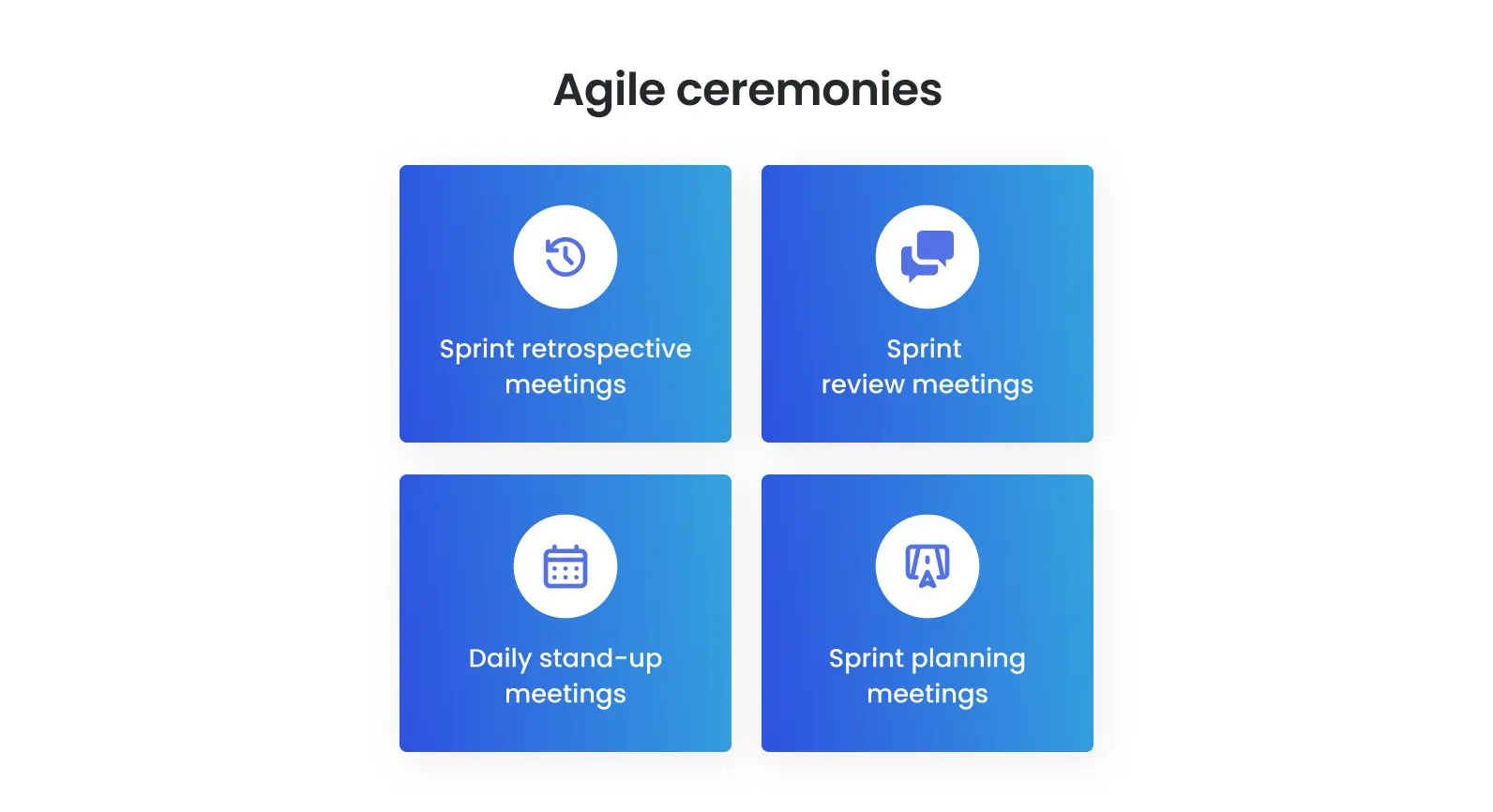Today, the likelihood of finding a team working according to Waterfall or any other pre-Agile methodology is about as high as spotting a floppy disk in a modern office. No wonder, 71% of companies surveyed in the 17th State of Agile Report use Agile in their SDLC.
The goal of Agile teams is to quickly and sustainably deliver new updates, and traditional testing isn’t a good match for this. The rapid pace of Agile development requires Agile testing—just the way we test at DeviQA. Let’s explore this approach and its best practices.
Moving from traditional to Agile testing
Traditionally, testing was treated as a separate phase of the SDLC that came into play just after the completion of the development phase. The QA process was well-planned, with an emphasis on detailed documentation and intolerance to changes on the go.
While testing was quite comprehensive, it was also time-consuming. QA engineers typically worked as a separate team, with limited direct collaboration with developers and other stakeholders.
This approach worked well for decades until the advent of the Agile methodology — or rather philosophy — which radically changed the way modern software is developed.
Flexibility, rapid and iterative product delivery, close communication, a continuous feedback loop, and ongoing improvement lie at the heart of the Agile software development methodology.
As long as testing within this methodology is not just a standalone phase but is integrated with the development process, its practices align closely with the Agile principles.

In Agile environments, QA engineers work in tight-knit cross-functional teams where product quality is a shared responsibility. Testing starts early and is executed continuously to prevent and catch bugs as they emerge, reducing time, effort, and costs for fixes.
To keep pace with software development and shorten testing cycles, tests are automated whenever relevant. QA engineers regularly review and refine applied strategies to ensure maximum efficiency. Additionally, the QA process in Agile can be quickly adjusted to new requirements, at least as soon as in the next iteration.
What is the main goal of Agile testing? It’s not only to ensure the top-notch quality of software but to achieve it while keeping the testing process fast, flexible, and efficient.
So, traditional and Agile approaches to testing differ a lot. The table below showcases their key differences in a structured way:
Sequential. Testing is executed as a separate phase late in the project timeline after development is completed.
Iterative. Testing starts early and is executed throughout development.
QA engineers rely on well-documented test plans and test cases.
QA engineers use lightweight and rapidly changing documentation.
Customer involvement is limited until final product delivery.
Continuous customer involvement is encouraged, as feedback plays a significant role in tweaking the development and testing processes.
Less flexible. It is difficult to accommodate changes.
Highly adaptable to changing requirements.
QA teams may rely more on manual testing.
QA teams widely use test automation for efficiency.
Bugs are detected late, often after significant development work.
Bugs are identified early and addressed during development.
There is a high risk of late-stage bugs.
Risks are mitigated as testing is continuous and early.
A QA team works separately from the rest of the teams. Communication is limited.
QA engineers are members of a cross-functional Agile team, where close communication is established.
Benefits of Agile testing

What are the advantages of Agile software testing services? When implemented properly, they bring a lot of benefits, enabling businesses to achieve their goals. Here are some of the most prominent ones you should know:
Better quality of software
In Agile testing, quality is not a final checkpoint but an ongoing process. Thanks to automation, tests are executed regularly in each iteration, catching bugs as they emerge and not letting them turn into serious problems later.
Besides, thanks to the focus on automation, QA engineers have enough time for more creative tasks and complex test scenarios that require human attention.
The right balance between automated and manual testing ensures extensive test coverage, while constant refinement of QA processes guarantees effectiveness. As a result, Agile teams deliver software products of unmatched quality.
Fast delivery
The mission of Agile testing suggests not only ensuring exceptional quality but also doing it at high speed – time is of the essence in any business. Unsurprisingly, automation plays the biggest role, saving time and resources while ensuring accuracy and consistency.
Teams that adopt DevOps services and solutions practices take it a step further, integrating automated tests into CI/CD pipelines for continuous testing and deployment. Other facets, such as the shift-left approach, risk-based testing, and close collaboration between testers and developers, also contribute to the speed of Agile testing.
The upshot is that testing moves in sync with rapid development cycles, allowing businesses to roll out new features and updates faster than ever.
Flexibility
Changes are inevitable in software development, whether it's due to new market demands, updated regulations, or user feedback.
Agile testing is set up to embrace changes rather than resist them. Since testing is done iteratively, in short cycles, teams can quickly make adjustments without derailing the entire project. If a feature is tweaked, it can be retested right away.
This flexibility reduces stress, saves time, and ensures the alignment of a final product with real-world needs.
Happy users
Agile testing keeps users involved throughout the development process by gathering feedback and incorporating suggested changes. In such a way, it ensures the final product meets their expectations. At the end of the day, software is only as good as the value it delivers to users.
Also, the high-quality standards and frequent updates mentioned above further improve user satisfaction and loyalty. And where there are happy users, there are more subscriptions and higher revenues.
So, Agile testing is all about efficiency and speed, impacting the entire development process and business outcomes.
Best Agile testing practices
We’ve found out that Agile testing is advantageous and even essential for Agile environments. The next question is how to implement it in the right way. The secret lies in embedding the mix of the best Agile practices and the best software testing practices. Here are the key ones:
Early and continuous testing
The shift-left approach, which suggests initiating testing activities at the earliest stages of development, enables teams to catch and fix bugs promptly.
This practice cuts the cost and time associated with late-stage bug fixes, as well as contributes to better product quality. Shift-left testing adoption can result in a 50% reduction in bugs found in the production environment and shorten time to market by 40%.
Yet, in Agile, testing should be not only early but also continuous. Tests are executed in every iteration to ensure the smooth work of new features and the stability of existing ones. This strategy facilitates quick feedback and adaptation, aligning the development process with business requirements and user needs.
Active test automation
As mentioned, in Agile, tests should be executed repeatedly. That’s not that easy, taking into account the fact that regression and smoke suites expand iteration by iteration.
To meet a deadline while ensuring its comprehensiveness and accuracy, Agile teams take advantage of automation that significantly speeds up the testing process and allows for more frequent testing cycles. The majority of teams aim to automate between 50% and 75% of their testing process.
Close collaboration and communication
It’s no secret that efficient communication is paramount for any venture, which is why it’s one of the fundamental Agile principles. Agile encourages working in cross-functional teams with shared responsibility for quality, ensuring that testers, developers, and stakeholders work closely together.
Also, it promotes holding diverse ceremonies—daily standups, sprint planning, sprint reviews, etc.—to keep everyone on the same page, settle issues promptly, and ensure a clear understanding of project goals and requirements by every team member.

Regular feedback collection
Agile teams use efficient feedback collection mechanisms to gain insights from end-users. This lets them trim the sails to the wind, refining project requirements and making informed business decisions. Companies that actively incorporate feedback from real users into their projects often achieve higher customer satisfaction and product relevance.
Continuous improvement
If you want to succeed with Agile testing, improve your QA process relentlessly. Remember that every iteration is an opportunity to refine strategies, eliminate weaknesses, and make adjustments for further improvement. The “lessons learned” framework from each iteration is applied to the next, driving efficiency and enhancing product quality.
Tips for implementing Agile testing
Nailing Agile testing takes more than just sticking to the basics. While the fundamentals set the stage, a few extra strategies can make implementation smoother and boost efficiency. Here are some worth considering:
Establish a quality-driven culture
Make quality the responsibility of everyone on the team, not just QA engineers, and bake testing into every aspect of the software development. When developers, testers, designers, PMs, etc. start thinking about quality before even the first line of code is written, teams are more likely to produce functional, reliable software with fewer bugs in the long run.
Prioritize testing for critical features
Put your testing efforts where they matter most — on features that are more likely to break or are crucial to the business. Prioritize tests based on user impact, business value, and feature complexity. This risk-based approach to testing ensures that critical features get extra attention and eliminates the need to test every single detail.
Encourage pair testing
Pair testing suggests tackling testing tasks by two people — typically a developer and a tester—who collaborate to explore functionality, identify bugs, and ensure quality. This technique accelerates the testing process, fosters knowledge sharing within the team, and reduces silos between developers and testers, facilitating stronger collaboration and higher-quality output.
Automate smartly
While automation is definitely essential in Agile testing, it’s important to automate wisely, i.e., automate the right tests at the right time. Focus on automating repetitive and high-impact tests — such as regression and/or smoke tests — to speed up the process. However, resist the temptation to automate everything.
Some tests still require human intuition and creativity, making manual testing essential and valuable as well. The key is finding the right balance between automated and manual testing.
Incorporate CI/CD
СI/CD and Agile are a perfect combo, just like strong coffee and early morning standups. Automated tests integrated into a CI/CD pipeline run automatically whenever new code is pushed, catching bugs instantly instead of letting them bulk up. This approach can decrease the number of post-deployment bugs by 65%. Faster feedback facilitates faster fixes, fewer last-minute surprises, and a smoother development flow without unnecessary downtime.
Keep test documentation concise
In Agile, less emphasis is put on extensive documentation compared to the traditional approach. Instead of writing multipage test plans and super-detailed test cases, prepare light, concise, and up-to-date documentation that provides just enough data for the team to understand the scope and requirements. By minimizing documentation overhead, teams can save time and faster adapt to changes. It's a shift from traditional testing with rigid documentation to a more dynamic and adaptive process.
Refine your QA process
Hold retrospectives after each iteration, where team members can discuss what worked and what didn’t. Encourage testers, developers, and stakeholders to share their feedback in order to identify bottlenecks or weaknesses. Regular collection and analysis of QA metrics can also help.
Test execution time, automated test coverage, and defect leakage rate are key QA metrics in Agile. Tweak your QA strategies as your project evolves. Give a try to new testing tools and techniques if they promise to enhance your workflows. Agile allows you to pivot quickly, so don’t be afraid to experiment to reveal what works best for your project.
Conclusion
A properly set up Agile QA process ensures high software quality, flexibility, fast product delivery, and, ultimately, high user satisfaction.
Wish to bring in QA experts with years of hands-on experience in Agile QA services at a fraction of the cost? Contact DeviQA and build and maintain a highly efficient QA process that perfectly aligns with your development pace.
Similar Posts
14 minutes to read
What is agile QA testing and why you need it in software testing
- Agile testing
14 minutes to read
Agile QA testing in Scrum vs. Kanban
- Agile testing
12 minutes to read
Agile software testing impact on business
- Agile testing
5 minutes to read
Why are code reviews critical for software quality and team efficiency?
- General
